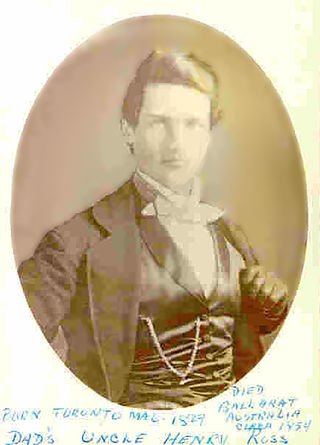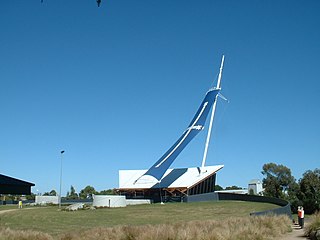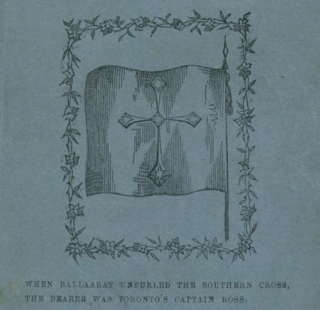The Eureka Rebellion was a series of events on the Victorian goldfields from 1851 to 1854. It culminated in the Battle of the Eureka Stockade fought between miners and the colonial forces of Australia at Ballarat on 3 December 1854.
Eureka Stockade may also refer to:

The Eureka Rebellion was a series of events involving gold miners who revolted against the British colonial government in Victoria, Australia during the Victorian gold rush. It culminated in the Battle of the Eureka Stockade, which took place on 3 December 1854 at Ballarat between the rebels and the colonial forces of Australia.
Eureka often refers to:

The Eureka Flag was flown at the Battle of the Eureka Stockade, which took place on 3 December 1854 at Ballarat in Victoria, Australia. It was the culmination of the 1851–1854 Eureka Rebellion on the Victorian goldfields. Gold miners protested the cost of mining permits, the officious way the colonial authorities enforced the system, and other grievances. An estimated crowd of over 10,000 demonstrators swore allegiance to the flag as a symbol of defiance at Bakery Hill on 29 November 1854. It was then flown over the Eureka Stockade during the battle that resulted in at least 27 deaths. Around 120 miners were arrested, and many others were badly wounded, including five soldiers.

Peter Fintan Lalor was an Irish-Australian rebel and, later, politician who rose to fame for his leading role in the Eureka Rebellion, an event identified with the "birth of democracy" in Australia.

John Basson Humffray was a leading advocate in the movement of miner reform process in the British colony of Victoria, and later a member of parliament.

Henry Ross was a Canadian-Australian gold miner who died in the Eureka Rebellion at the Ballarat gold fields in the British Colony of Victoria, now the state of Victoria in Australia. Ross is particularly remembered for his part in the creation of the rebel miners' flag, since named the Eureka Flag.

Henry Erle Seekamp was a journalist, owner and editor of the Ballarat Times during the 1854 Eureka Rebellion in Victoria, Australia. The newspaper was fiercely pro-miner, and he was responsible for a series of articles and several editorials that supported the Ballarat Reform League while condemning the government and police harassment of the diggers. After the Rebellion was put down, he was charged, found guilty of seditious libel, and imprisoned, becoming the only participant to receive gaol time.

Charles Alphonse Doudiet was a Swiss-born Canadian artist and digger present at the Eureka Stockade, Ballarat, in the British Colony of Victoria, in 1854. His sketchbook, discovered by his descendants in 1996, has provided contemporary images of events connected to the Eureka Rebellion, that were important for the authentication of the original Eureka Flag.

Eureka Stockade is a 1949 British film of the story surrounding Irish-Australian rebel and politician Peter Lalor and the gold miners' rebellion of 1854 at the Eureka Stockade in Ballarat, Victoria, in the Australian Western genre.
The following lists events that happened during 1854 in Australia.

The Ballarat Reform League came into being in October 1853 and was officially constituted on 11 November 1854 at a mass meeting of miners in Ballarat, Victoria to protest against the Victorian government's mining policy and administration of the goldfields.

Eureka is a small eastern suburb of Ballarat, Victoria, Australia. It was originally part of Ballarat East but became its own suburb in 1946 in recognition of the area's significance to Australian history. Eureka is bordered by Specimen Creek to the north, Canadian Creek to the south, Queen and Joseph streets to the west and Kline and Stawell Street to the east. The suburb takes its name from the Eureka Lead – a lead is an ancient river bed that contains gold – of the Eureka Mining Company and is most notable as the site of the historic event of the Eureka Rebellion. This was the site where the rebel miners flew the Eureka Flag for the first time; a flag that has since become a symbol of the working class and trade union movement and, at times, Australian republicanism.

Eureka Stockade is a 1907 Australian silent film about the Eureka Rebellion. It was the second feature film made in Australia, following The Story of the Kelly Gang.

The Battle of the Eureka Stockade was fought in Ballarat, Victoria, Australia on 3 December 1854, between gold miners and the colonial forces of Australia. It was the culmination of the 1851–1854 Eureka Rebellion during the Victorian gold rush. The fighting resulted in at least 27 deaths and many injuries, the majority of casualties being rebels. The miners had various grievances, chiefly the cost of mining permits and the officious way the system was enforced.

The Eureka Jack Mystery relates to the creation and flying of a rebel Australian flag known as the Eureka Jack. Its origin is not specifically known.
The following bibliography includes notable sources concerning the Eureka Rebellion. This article is currently being expanded and revised.

Edward Thonen was a German emigrant to Australia, and one of the miners involved in the Eureka Rebellion in Ballarat, Victoria. He was captain of one of the miners' divisions. When soldiers stormed the Stockade on 3 December 1854 in the Battle of the Eureka Stockade, Thonen was one of the first to be killed.

The Eureka Rebellion, an 1854 gold miner's revolt in Victoria, Australia, has been the inspiration for numerous novels, poems, films, songs, plays and artworks. Much of Eureka folklore relies heavily on Raffaello Carboni's 1855 book, The Eureka Stockade, which is the first and only comprehensive eyewitness account of the uprising. The poet Henry Lawson wrote about Eureka, as have many novelists.
The Eureka Rebellion was a series of events on the Victorian goldfields from 1851 to 1854. It culminated in the Battle of the Eureka Stockade fought between miners and the colonial forces of Australia at Ballarat on 3 December 1854.

The Eureka Stockade is an 1855 novel by Raffaello Carboni, who was present in Ballarat during the Eureka Rebellion. He lived near the Eureka Stockade and witnessed the battle on 3 December 1854 when the government forces defeated the rebel garrison. The Eureka folklore is deeply indebted to Carboni's novel, the first and only comprehensive eyewitness account of the Eureka Rebellion.